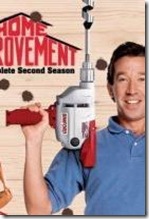There is something wonderful in this simple philosophy. It certainly is an aggravation saver, and I believe it is a good, honest, tip for a happier life. It is applicable in all aspects of our daily lives -- including our tech gadgets.
Some people (me), though, have some malformed gene, or mis-wired section in their brain which renders them constitutionally incapable of keeping their mischievous little fingers off of a perfectly functioning device. These people have a strange compulsion to try to "make it better". They just have to open it up and look at what's inside...
A highly Scientific Study (that I just made up) has proven that a full 9-out-of-10 of these personality-types not only fail to "improve" the device, they fail to get all the pieces back inside, much less back in their proper places.
back inside, much less back in their proper places.
The modern name for these people is "tweaker". The most 'famous' tweaker was probably Tim ["the tool man"] Taylor, a character made famous by Tim Allen on Home Improvement. (I loved it when he "improved" the kitchen garbage disposal by powering it with a chainsaw engine.) His motto: More power!
Yes, "if it ain't broke, don't fix it" is a very good Rule. For that 90% of tweakers who only succeed in disassembling the object of their interest, it ought to be a Law. However (you, Dear Reader, were expecting a "however", right?), tweaking can be a good thing. Tweaking sometimes leads to Invention. Successful and repeatable tweaks are called "optimizing". And who can argue against optimizing? Not me. A great deal of Tech--for Everyone is about optimizing your PC.. such as today's tip.
Tip of the day: Optimize your computer with the latest device drivers. Most of my readers should be aware of the existence of the small programs that allow the software on our machines (primarily the OS) to interact with the hardware, which are called "device drivers". If you've ever added a new device, you (typically) had to put in a CD and install the "driver" to get it operational. My readers probably also know that, like other programs, drivers get "updated", and improved, occasionally. Did you also know that by seeking out, and installing the latest drivers, you can have a faster machine? Or, that your device may suddenly have more "features" and capabilities? Today I'm going to show you a method to use that I consider the first step, and tomorrow I'll describe the more aggressive and effective approach, as well as how to "undo" a driver update if things should go wrong.
The first step is to create a System Restore point, to give yourself a fallback position. I reco doing this whenever you make significant changes to your machine. (To see my series on the System Restore tool, click here.)
Then you need to access your Device Manager tool. There are a couple of ways to do this, but I use Start >right-click My Computer >Properties >Hardware tab >Device Manager. Now you will see a list of the components on your machine, as shown in the example below. Some, in fact most, of these items you do not need to worry about updating. The items that typically will give you the most improvement are: graphics, sound, printer, network (or modem) adapter, and (sometimes) monitor.
Begin by selecting the device you want to update the driver for -- I am going to use for demonstration the sound on a laptop computer -- and 'expand' the hardware list by clicking on the "+" sign next to the proper category, in my example that will be the "Sound, video, and game controllers" category.
Next, double-click on the device name to open its Properties dialogue window. In my case that's "ESS Maestro PCI Audio", and then click on the Drivers tab, which will now open a window that looks like this.
Now click on the Update driver button, which launches an automated process called the "Hardware Update Wizard". Accept the default radio button setting ("Automatically") and click "next".
Now Windows will go out and "search" for a "better" driver than the current version, and when it finds one, will help you install it via a couple of "Next" clicks. Do this for all the devices (device types) that I listed above.
Unfortunately, the most common result of the search returns this window.
This is because Microsoft has built into the search parameters a complex formula of what constitutes "better". To them, better does not just mean "newer" (ie, a more recent version number), but whether or not the driver has been tested and approved in the Microsoft labs (for a fee), and whether or not the driver's author has shelled out the dough to buy a digital "certificate" (for another fee).
Since this is a simple driver, and not a new miracle accounting program, or other retail piece of code, most authors skip these expensive steps... and so the Update search will disregard these drivers as if they didn't exist. Tomorrows post will deal with this issue.
But doing this process can and does produce results, and it is the method I reco as the first step in a faster/better PC. New drivers are released all the time, so I do this every so often.
To read Part 2, click here.
Today's free link: I have reco'd the popular Mozilla Firefox web browser here before, and I think it's only fair to tell you of another -- Avant uses the IE 7 rendering engine, but advertises itself as the "fastest browser on earth". I like it for its built-in security features, such as tracks erasing, and its rss reader. Take a look at the Avant homepage, and then give it a try.
Copyright 2007-8 © Tech Paul. All rights reserved.
No comments:
Post a Comment